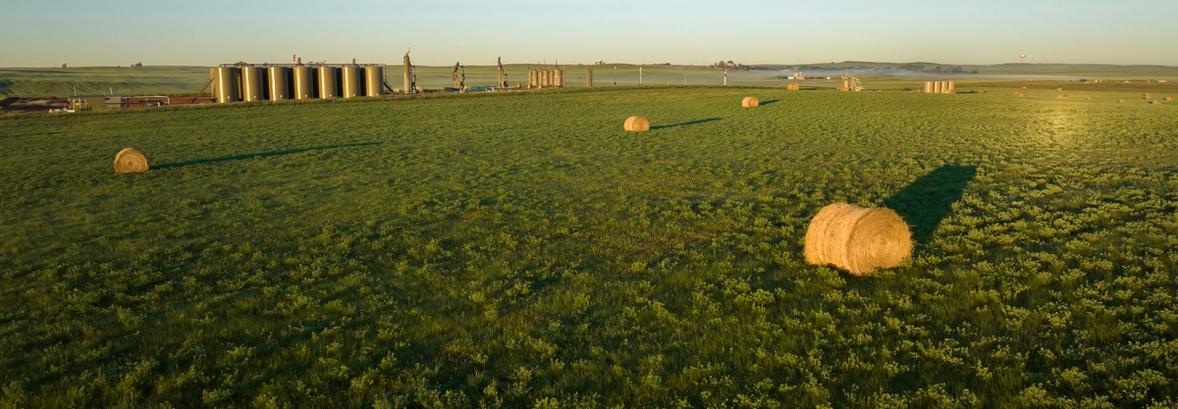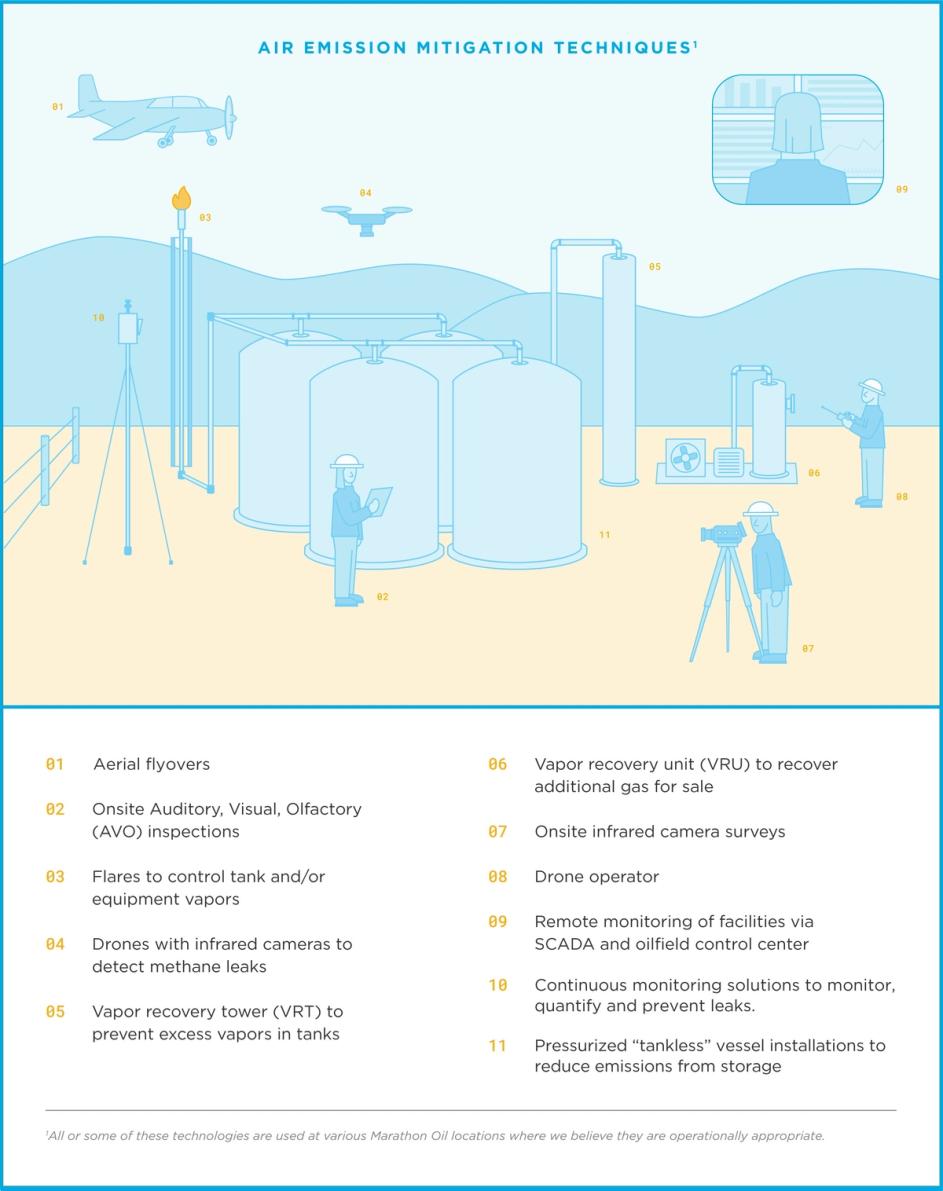

Emissions Management
During 2021, Marathon Oil made significant progress against our core environmental objectives, achieving our greenhouse gas (GHG) intensity reduction target of 30%, with a 37.7% reduction compared to our 2019 baseline. This reduction was driven by improvements in gas capture, streamlined supply chain infrastructure that resulted in a reduction in flaring and utilizing other emission reduction technologies. Our annual GHG intensity metric is included in our corporate scorecard and linked to employee pay.
Marathon Oil believes that emissions intensity is a more appropriate way to measure improvement as impacts due to production changes are incorporated. However, we also saw a significant decline in our absolute GHG emissions. In 2021, total Scope 1 and 2 absolute emissions were 47.7% lower than our 2019 absolute emissions baseline over a 16% decline in production. The electricity we use is primarily provided by regulated entities, which limits our ability to directly purchase renewable power. We utilized renewable energy credits to eliminate Scope 2 emissions on a net basis.
While methane intensity in 2021 was higher than our 2019 baseline due to production decline and inventory methodology adjustments, methane emissions intensity decreased from 2020 despite additional production declines. This is due to concerted efforts to reduce instrument gas-driven pneumatic controllers and reductions in flaring. More specific details regarding our data and performance against goals and targets are provided here and in the following charts. Our calculation methodology is footnoted below.¹
- ᵃ Gross Basis
- ᵃ 2021 process emissions include bolt-on acreage in the Eagle Ford.
- ᵇ Tonnage by source is gross and does not include impact from offset retirement.
- ᵃ Greenhouse gas (GHG) carbon dioxide equivalent (CO₂e) emissions are based on carbon dioxide, methane and nitrous oxide from Marathon Oil-operated facilities only.
- ᵇ UK assets divested in 2019.
- ᶜ 2021 value is net GHG, incorporating 12,500 MT of retired REDD+ offsets for each asset and REC offset for Scope 2 emissions.
- ᵃ UK assets divested in 2019.
- ᵇ Increase in 2020 was due to a counting discrepancy discovered during in-housing of the GHG inventory, and production decline.
- ᶜ When compared to historic performance, the profile of emissions sources shifted substantially due to focused efforts to reduce associated gas flaring in the Bakken. Increased percentages in other areas don’t reflect an increase in emissions from that source, rather a composition change over a smaller total emissions base.
Carbon Offsets
Marathon Oil has purchased double gold certified carbon offsets applied against our Scope 1 emissions (<1.5% – see Five-Year Performance table). These certified carbon mitigation credits invest in economic alternatives for local communities who are protecting their forests.
The primary project we invest in is the Wildlife Works Reducing Emissions from Deforestation and Degradation (REDD+) Project located in the rainforest of the Congo Basin. We have committed to a five-year partnership designed to protect forests that would otherwise be at risk of deforestation, thereby avoiding the release of millions of carbon emissions and maintaining a critical ecosystem.

Investing in the Mai Ndombe REDD+ Project
Marathon Oil’s primary focus is reducing emissions from operations. However, we are developing expertise in the use of carbon offsets as a tool to manage hard-to-mitigate sources of emissions in our operations. Protecting natural carbon sinks like forests and grasslands is one of the most cost-effective forms of carbon mitigation, and addressing deforestation is critical to limiting global temperature rise to 1.5°C.
The loss of humid tropical forests added 2.5 billion tons of carbon dioxide emissions into the atmosphere in 2021,¹ and deforestation is responsible for approximately 12% of annual global greenhouse gas (GHG) emissions.² Out of all of Earth’s forests, the Democratic Republic of Congo saw the second-most tropical primary forest loss in 2021.³
Forest Conservation
The Mai Ndombe Project, run by Wildlife Works, protects 300,000 hectares (740,000 acres) of forest in the Congo Basin. This forest is the world’s second-largest intact rainforest, contains some of the most important wetlands on the planet and provides critical habitats for bonobos, elephants and other wildlife. To date, the Mai Ndombe REDD+ Project has avoided more than 36 million metric tons of CO2 emissions and protects two International Union for Conservation of Nature (IUCN) Red List threatened animal species.
Community Prosperity
The conservation success of the Mai Ndombe REDD+ Project is founded on the direct investments that carbon revenues deliver to more than 30,000 local and Indigenous Peoples living within the project area. These communities depend significantly on the critical health, education, agricultural and sanitation services that the project provides, as there are essentially no government services in this remote forest area and no other source of financial or capacity-building support for the communities.
The project creates an important economic case for forest conservation by giving agency to local and indigenous communities in developing and implementing self-governed economic alternatives to protect natural resources.
Carbon offset investments in Mai Ndombe are creating a new pathway for community prosperity, with investments being used to address needs the community has identified as essential to their well-being. This includes building and renovating schools, providing healthcare services and access to immunizations, creating job opportunities that empower local people – particularly women – providing access to clean water and scaling sustainable agriculture.
The project has committed to building 32 schools over the first 25 years. As of 2021, the project has built 11 schools that will impact over 8,000 students and seven more are currently under construction. In addition, the project has built one of five health clinics that it is committed to building over the next two years and will refurbish two regional hospitals. The project also implemented and provides ongoing support for a mobile medical clinic that is now treating thousands of patients who previously had little or no access to healthcare. Over 1,700 people have reported improved livelihoods and income generated as a result of the project.
Emissions Reduction Strategies
In early 2021, we earmarked $100 million over a five-year period for emission reduction projects. Several of our emissions mitigation techniques are depicted in the graphic below. Additional reduction technologies are described here.

Environmental Proceedings
In January 2020, we received a Notice of Violation from the EPA alleging Clean Air Act violations associated with our North Dakota operations. Enforcement action is expected to result in monetary sanctions and injunctive requirements.
While the ultimate outcome for us cannot be predicted with certainty, we believe these enforcement actions will not have a material adverse effect on our consolidated financial position, results of operations or cash flows.
We’re cooperating fully with associated federal agencies and are aggressively working in a transparent manner to confirm ongoing compliance with applicable requirements. Specifically, we’re reviewing and enhancing how we design closed-vent systems and calculate air emissions. The full extent of the injunctive terms and penalty amount are not yet known. We take such allegations and issues very seriously and are focused on enhancing our systems and programs.
How are we doing?
Your opinion matters. Please take a moment to let us know how useful you find the content on this page.
If you’d like to give us your feedback on the entire report, please fill out the complete survey for the 2021 report.



















